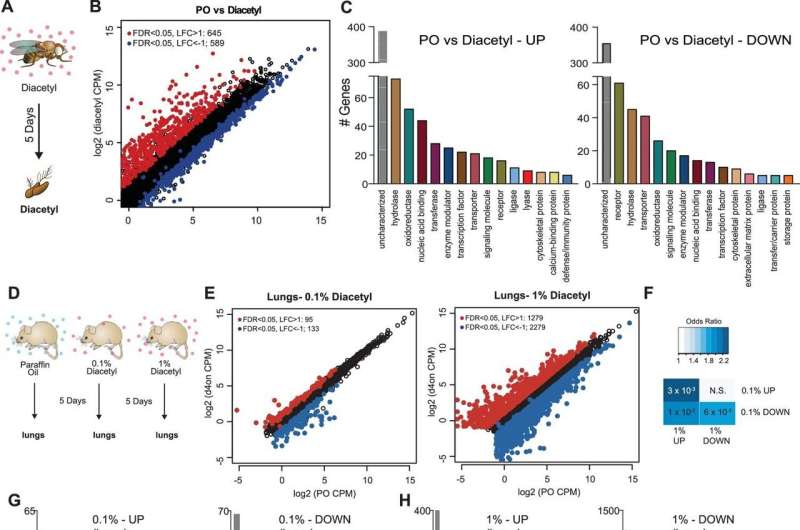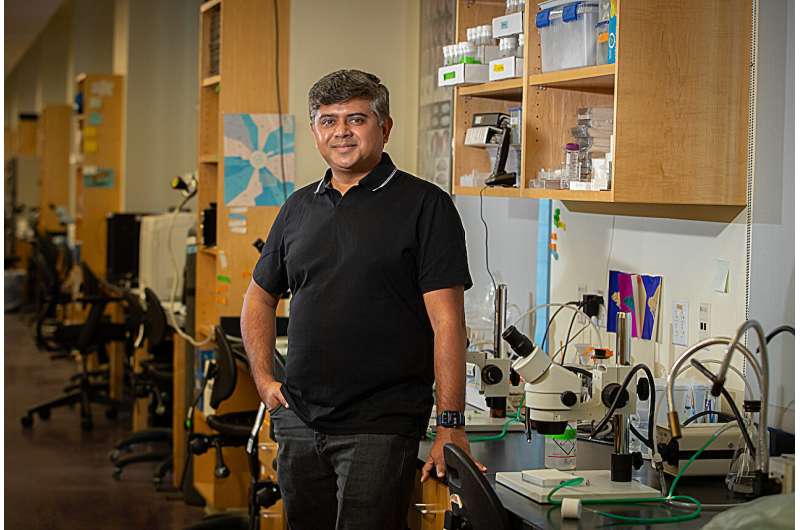This article has been reviewed according to Science X's editorial process and policies. Editors have highlighted the following attributes while ensuring the content's credibility:
fact-checked
peer-reviewed publication
trusted source
proofread
New research finds that exposure to odorant-based HDAC inhibitors could delay neurological disease onset

Imagine if we could inhale scents that delay the onset of cancer, inflammation, or neurodegenerative disease. Researchers at the University of California, Riverside, are poised to bring this futuristic technology closer to reality.
In lab experiments, a team led by Anandasankar Ray, a professor of molecular, cell and systems biology, exposed the fruit fly (Drosophila melanogaster) to diacetyl, a microbial volatile compound released by yeast, and found changes in gene expression in the fly's antennae in just a few days. In separate experiments, the team found similar gene expression changes in mice and human cells.
"That exposure to an odorant can directly alter expression of genes, even in tissues that have no odorant receptors, came as a complete surprise," Ray said. "These molecules are able to get to the cell nucleus through the cell membrane."
Diacetyl is widely used in food and beverage flavorings. It occurs naturally in a variety of dairy products and is a natural byproduct of fermentation and brewing. While diacetyl is found in beer, wine, Greek yogurt, and many ripening fruits, it is considered unsafe to inhale at high concentrations.
"Our initial discovery was made using diacetyl, as a proof of concept, and this compound may not be the perfect candidate for therapy," Ray said. "We are already working on identifying other volatiles that lead to changes in gene expression. Our important finding is that some volatile compounds emitted from microbes and food can alter epigenetic states in neurons and other eukaryotic cells. Ours is the first report of common volatiles behaving in this way. It opens an entire field of inquiry. The possibilities are limitless."
The research, published in eLife, shows that alterations in gene expression and chromatin—the mixture of DNA and proteins that form chromosomes—are possible in an organism even without the organism actively consuming the volatile compound source. The source could even be at some distance from the organism.
"We have shown for the first time that some of these odor molecules to which we are exposed and are being absorbed into the cells of our skin, nose, lungs, even probably to the brain through the bloodstream are fundamentally altering gene expression," Ray said. "Is this something to be concerned about? How is it affecting our predisposition to certain diseases? How exactly is it affecting the genes we express? These remain unanswered questions."
Ray's team found that diacetyl can act as an inhibitor of histone deacetylase, or HDAC, enzymes and discovered several related volatiles with similar potential. HDAC inhibitors are used as anti-cancer drugs and may find use also in treating inflammatory diseases as well as neurodegeneration. When HDACs—which are conserved in plants and animals—are inhibited, DNA gets less compactly wound in cells, leading to more gene expression.
"This opens the potential for odorant-based HDAC inhibitors to delay neurodegeneration or memory deficits in diseases," Ray said.

In the fruit fly, Ray's team found exposure to diacetyl volatiles substantially slowed degeneration of photoreceptor cells linked to Huntington's disease. In transgenic mice, the team found exposure to diacetyl showed gene expression changes in lungs and brains; gene levels that are upregulated in cancers like neuroblastoma showed a significant reduction in mice exposed to diacetyl.
In human cell lines, the team found diacetyl changed acetylation levels, with higher levels of acetylation resulting in higher levels of gene expression. In further testing on human cancer cell lines, the team found that exposure to diacetyl prevented proliferation of neuroblastoma.
Apart from human diseases, the research has enormous implications for agriculture. Because HDACs are highly conserved, they also affect plants.
"Plants appear to have a very strong response to some of these volatiles," Ray said. "In plants, any process that requires changes in gene expression can now be affected via exposure to this special class of odorants."
Ray explained that the volatiles are like tiny drugs that can change levels of gene expression and exploit the plant's genetic potential for improving growth of roots, leaves, flowers and even responses to abiotic stress like freezing and drought.
"Volatile chemicals can deliver a therapeutic dose to plants and animals, with no need for pills or injections," he said. "They can simply be breathed in, almost giving a new meaning to scent-based therapy."
With the help of the Office of Technology Partnerships at UCR, Ray has filed patents for volatiles that can slow down neurodegeneration and cancer and alter plant growth and responses to stress.
More information: Sachiko Haga-Yamanaka et al, Plasticity of gene expression in the nervous system by exposure to environmental odorants that inhibit HDACs, eLife (2024). DOI: 10.7554/eLife.86823.3




















